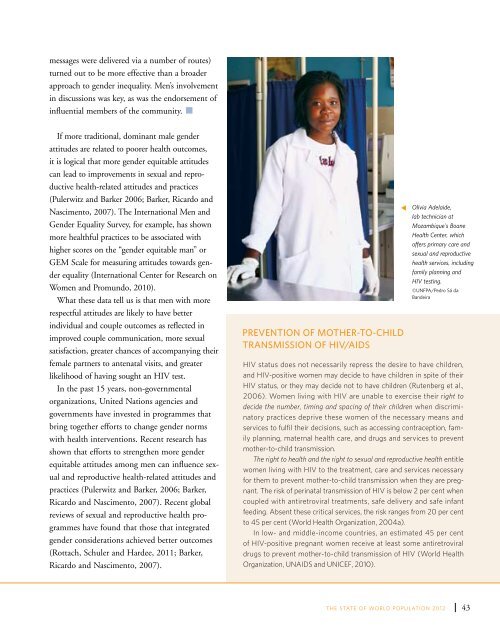State of World Population 2012 - Country Page List - UNFPA
State of World Population 2012 - Country Page List - UNFPA
State of World Population 2012 - Country Page List - UNFPA
Create successful ePaper yourself
Turn your PDF publications into a flip-book with our unique Google optimized e-Paper software.
messages were delivered via a number <strong>of</strong> routes)<br />
turned out to be more effective than a broader<br />
approach to gender inequality. Men’s involvement<br />
in discussions was key, as was the endorsement <strong>of</strong><br />
influential members <strong>of</strong> the community.<br />
If more traditional, dominant male gender<br />
attitudes are related to poorer health outcomes,<br />
it is logical that more gender equitable attitudes<br />
can lead to improvements in sexual and reproductive<br />
health-related attitudes and practices<br />
(Pulerwitz and Barker 2006; Barker, Ricardo and<br />
Nascimento, 2007). The International Men and<br />
Gender Equality Survey, for example, has shown<br />
more healthful practices to be associated with<br />
higher scores on the “gender equitable man” or<br />
GEM Scale for measuring attitudes towards gender<br />
equality (International Center for Research on<br />
Women and Promundo, 2010).<br />
What these data tell us is that men with more<br />
respectful attitudes are likely to have better<br />
individual and couple outcomes as reflected in<br />
improved couple communication, more sexual<br />
satisfaction, greater chances <strong>of</strong> accompanying their<br />
female partners to antenatal visits, and greater<br />
likelihood <strong>of</strong> having sought an HIV test.<br />
In the past 15 years, non-governmental<br />
organizations, United Nations agencies and<br />
governments have invested in programmes that<br />
bring together efforts to change gender norms<br />
with health interventions. Recent research has<br />
shown that efforts to strengthen more gender<br />
equitable attitudes among men can influence sexual<br />
and reproductive health-related attitudes and<br />
practices (Pulerwitz and Barker, 2006; Barker,<br />
Ricardo and Nascimento, 2007). Recent global<br />
reviews <strong>of</strong> sexual and reproductive health programmes<br />
have found that those that integrated<br />
gender considerations achieved better outcomes<br />
(Rottach, Schuler and Hardee, 2011; Barker,<br />
Ricardo and Nascimento, 2007).<br />
Prevention <strong>of</strong> mother-to-child<br />
transmission <strong>of</strong> HIV/AIDS<br />
Olivia Adelaide,<br />
lab technician at<br />
Mozambique's Boane<br />
Health Center, which<br />
<strong>of</strong>fers primary care and<br />
sexual and reproductive<br />
health services, including<br />
family planning and<br />
HIV testing.<br />
©<strong>UNFPA</strong>/Pedro Sá da<br />
Bandeira<br />
HIV status does not necessarily repress the desire to have children,<br />
and HIV-positive women may decide to have children in spite <strong>of</strong> their<br />
HIV status, or they may decide not to have children (Rutenberg et al.,<br />
2006). Women living with HIV are unable to exercise their right to<br />
decide the number, timing and spacing <strong>of</strong> their children when discriminatory<br />
practices deprive these women <strong>of</strong> the necessary means and<br />
services to fulfil their decisions, such as accessing contraception, family<br />
planning, maternal health care, and drugs and services to prevent<br />
mother-to-child transmission.<br />
The right to health and the right to sexual and reproductive health entitle<br />
women living with HIV to the treatment, care and services necessary<br />
for them to prevent mother-to-child transmission when they are pregnant.<br />
The risk <strong>of</strong> perinatal transmission <strong>of</strong> HIV is below 2 per cent when<br />
coupled with antiretroviral treatments, safe delivery and safe infant<br />
feeding. Absent these critical services, the risk ranges from 20 per cent<br />
to 45 per cent (<strong>World</strong> Health Organization, 2004a).<br />
In low- and middle-income countries, an estimated 45 per cent<br />
<strong>of</strong> HIV-positive pregnant women receive at least some antiretroviral<br />
drugs to prevent mother-to-child transmission <strong>of</strong> HIV (<strong>World</strong> Health<br />
Organization, UNAIDS and UNICEF, 2010).<br />
t<br />
THE STATE OF WORLD POPULATION <strong>2012</strong><br />
43
















